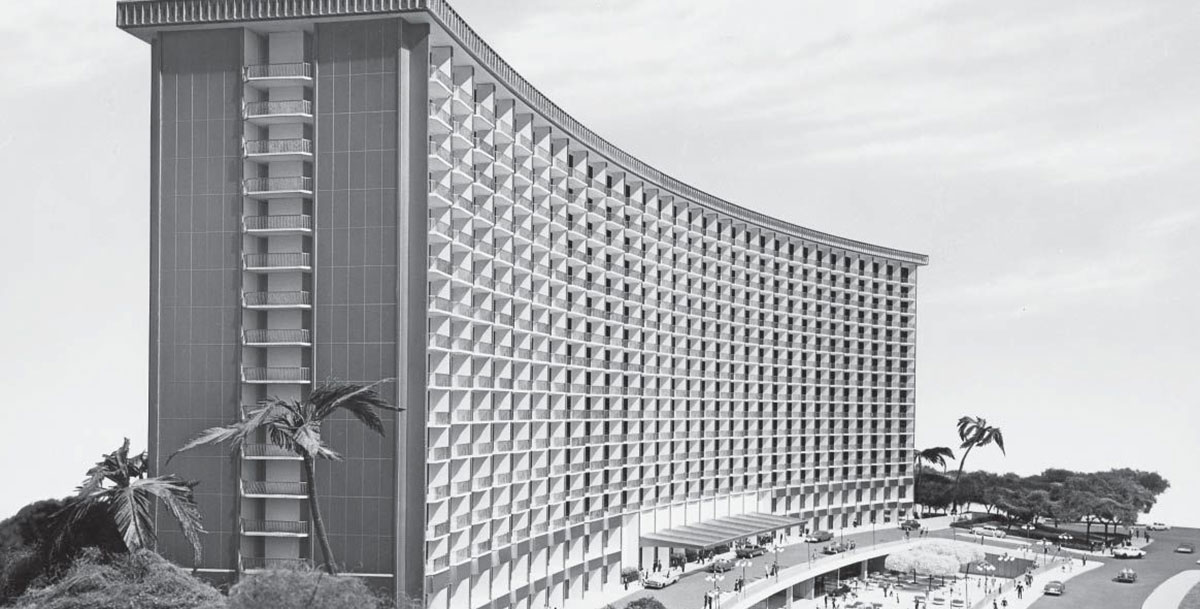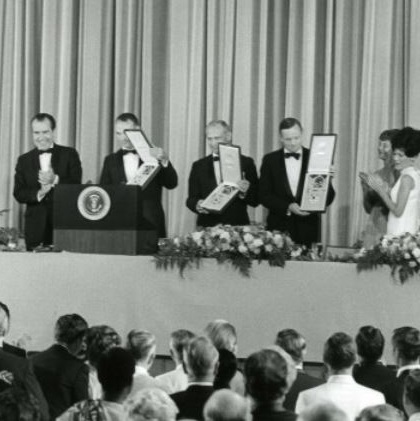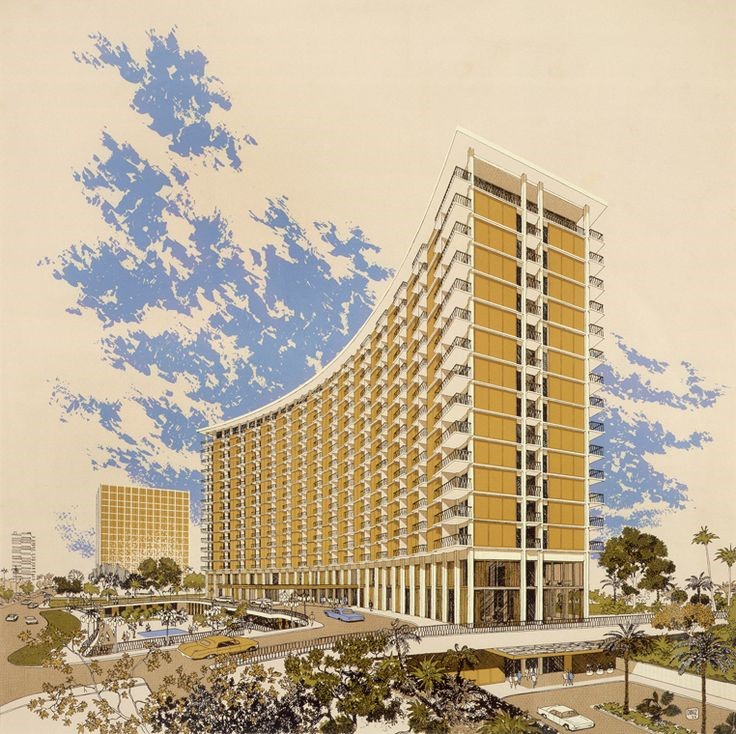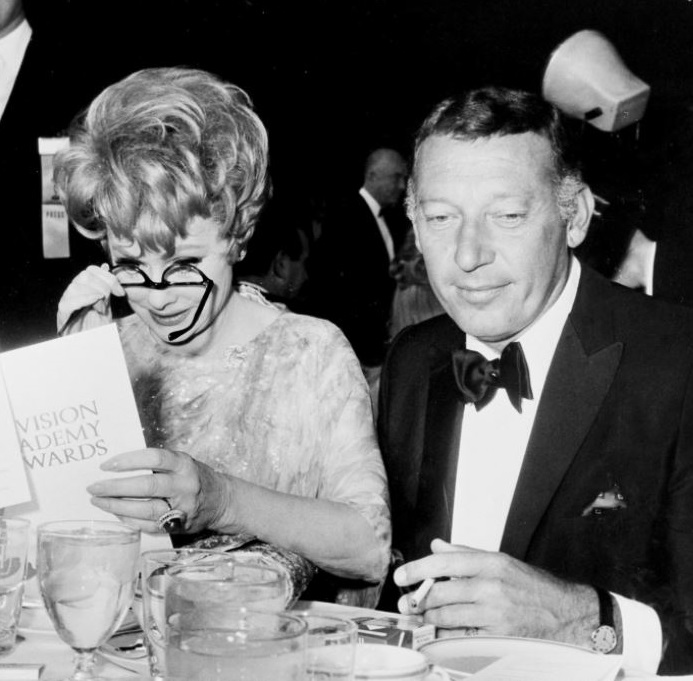Receive for Free - Discover & Explore eNewsletter monthly with advance notice of special offers, packages, and insider savings from 10% - 30% off Best Available Rates at selected hotels.
history
Discover the Fairmont Century Plaza, which was once hailed as “The Hotel of the Future” when it first opened during the 1960s.
Fairmont Century Plaza, a member of Historic Hotels of America since 2022, dates back to 1961.
VIEW TIMELINEIn 1961, real estate developer William Zeckendorf and ALCOA purchased nearly 180 acres from 20th Century Fox in downtown Los Angeles. (The studio had downsized amid a number of box-office flops that culminated with the film Cleopatra, at the time the most expensive movie ever made.) Zeckendorf and ALCOA then started to create a magnificent district known as “Century City.” While many upscale apartments and storefronts were planned to proliferate throughout the neighborhood, the two intended for an opulent boutique hotel to serve as its primary attraction. Named as the “Century Plaza Hotel,” work on the building began under the supervision of renowned architect Minoru Yamasaki. (Yamasaki designed many outstanding structures throughout his lifetime, including the plans for the original World Trade Center.) He proceeded to create a gorgeous building over the next several years that gradually dominated the local skyline. One of the world’s best Mid-Century Modern buildings, the Century Plaza Hotel stood 19 stories tall and featured 750 spectacular accommodations. Perhaps the structure’s most defining element was its unique arch, which made it resemble something like a crescent moon. Inside, Yamasaki created many fantastic public spaces, such as a spectacular lobby and an ornate grand ballroom. The guestrooms also contained some of the finest amenities of the age, like electric blankets, ice machines, and radios installed directly into the nightstands. The Century Plaza Hotel was even the first to offer color televisions—something that most American residences would not have for another decade!
When construction finally concluded in 1966, the Century Plaza Hotel quickly earned a reputation for its elegance and luxury. America’s most illustrious people soon began to appear at the hotel regularly, enchanted by its unrivaled service and sophisticated character. Numerous high-profile celebrities attended the opening gala, which was officiated by Bob Hope and Andy Williams. Even more celebrities arrived when the Century Plaza Hotel hosted the 19th Primetime Emmy Awards, as well as both the 12th and 13th Annual Grammy Awards. Other superstars could be spotted reserving guestrooms or holding small performances, as well. For instance, Sonny & Cher recorded their first live album on-site and Elton John gave an exclusive solo show entitled “Return to the Century” in one of the hotel’s venues. But the greatest patrons of all were several U.S. Presidents, including Lyndon B. Johnson, Gerald Ford, and George H.W. Bush. President Ronald Reagan visited often in particular, inspiring the media to refer to the building as the “Western White House.” Some presidents held their own events within the hotel, too. In 1969, President Richard Nixon hosted the “Dinner of the Century” at the Century Plaza Hotel, which was then the only Presidential state dinner hosted outside of the White House. Organized to celebrate the safe return of the Apollo 11 astronauts, the event was attended by aviation pioneers, celebrities, and the astronauts’ families. Fourteen members of President Nixon’s cabinet even came, as did representatives from over 80 other nations!
Despite its historical reputation, the hotel’s facilities had started to decay by the start of the 21st century. While several redevelopment efforts were launched to forestall the decline, the building’s demise still seemed imminent. The situation had grown so dire that in 2009, the National Trust for Historic Preservation named the Century Plaza Hotel as one of America's 11 Most Endangered Historic Places. Plans were even underway to demolish the structure in favor of a few high-rise condominiums. Thankfully, salvation arrived in the form of Woodbridge Capital Partners, which invested $2.5 billion into completely renovating the site. Construction began in earnest in 2016 and lasted a total of five years. The work was incredibly comprehensive, as it managed to thoroughly restore every aspect of the building’s fading historical architecture. But the construction also enhanced its amenities to better appeal to the tastes of modern travelers. In fact, the hotel’s guestroom count was lowered down to around 485, in order to provide more space for rest and relaxation. The historic Century Plaza Hotel finally reopened as the “Fairmont Century Plaza” to great local acclaim in 2021. Now a part of the collection that Fairmont Hotels and Resorts curates, this iconic historic hotel is once again one of Los Angeles’ leading luxury hotels. The hotel continues to host all kinds of prominent celebrities and star-studded events within its masterfully revitalized 1960s ambiance.
-
About the Location +
Now America’s second largest city, Los Angeles has a fascinating history that harkens back centuries. The first known inhabitants to occupy the region were several thousand Native Americans who were part of the Chumash and Tongva tribes. Living in villages, they built an interconnected society based on hunting, gathering, and trade. They also existed in relative isolation for generations until the Spanish arrived in 1769. Led by Gaspar de Portolá, the colonists had specifically created a rudimentary military base called a “presidio” in an attempt to protect Spain’s greater American Empire from other European countries. The Spanish soldiers were then joined by Franciscan priest Junípero Serra, who developed one of his Catholic missions near the fort two years later. While the region was sparsely populated, a group of 44 settlers eventually traveled to the complex to establish their own town. Consisting of individuals from all over the world, the settlers had hoped the community would give them a new opportunity to achieve prosperity. The pioneers finally showed up in 1781, and quickly set about forming the town. Called “El Pueblo de Nuestra Señora la Reina de los Ángeles,” it was as one of the only settlements in the area. Over time, it became known more simply as “Los Angeles” and serviced the numerous ranches that had opened nearby. Los Angeles nonetheless remained fairly small for many years thereafter, continuing to be nothing more than a frontier outpost even after Mexico won its independence from Spain in 1821.
Los Angeles began to change dramatically once California was incorporated into the United States following the Mexican-American War. The discovery of gold specifically ignited a massive wave of immigration, which saw places like Los Angeles grow exponentially. Local businesses expanded to meet the demands of the region’s growing population, making Los Angeles the site of a thriving economy. This economic activity grew further with the arrival of the railroads in the wake of the American Civil War, starting with the Southern Pacific Railroad in 1876. Around the same time, efforts were underway to transform Los Angeles into a major center for maritime shipping. Public officials took decades to work out the details, eventually annexing land a few miles away on the Pacific coast for the development of a natural harbor. The project proved to be extensive, taking several years to finish. But when the work finally concluded during the early 1900s, Los Angeles’ new deep-water harbor was hailed as one of the best on the planet. Los Angeles was the site of other engineering marvels as well, such as the Los Angeles Aqueduct, which transported gallons of water from hundreds of miles away. All of these developments transformed Los Angeles into an incredibly prominent city, with a population that reached into the hundreds of the thousands. Indeed, its metropolitan layout rapidly expanded in every direction and gradually absorbed a number of neighboring communities.
The city’s prominence continued well into the 20th century, where it steadily built upon its already strong economy and culture. By now, some of the nation’s largest corporations and factories had set up their national headquarters in Los Angeles. Among the greatest were military outfitters, specifically aircraft developers like the Douglas Aircraft Company, the Lockheed Corporation, and North American Aviation. Those entities remained fixtures in Los Angeles’ corporate culture for decades, especially during World War II and the Cold War. Another prominent industry to manifest was professional cinematography, which first emerged within the neighborhood of Hollywood. (Hollywood itself was one of the many towns that Los Angeles had integrated around the start of the century.) Dozens of prestigious movie studios soon proliferated throughout the area that produced hundreds of films every year. By the 1960s, the Hollywood film industry had consistently created a majority of world’s most commercially successful movies. As such, Los Angeles had become synonymous with the American cinema itself! Countless superstars were also starting to call the city home, too. In fact, many entertainers began to live in exclusive districts like Bel Air, Malibu, and West Hollywood. Los Angeles today remains a prestigious metropolis, as its unique cultural identity continues to draws tourists from around the globe every year. Few places can truly rival the brilliance of this iconic American city.
-
About the Architecture +
The Fairmont Century Plaza is an amazing example of Mid-Century Modern architecture. An offshoot of the earlier International and Bauhaus movements, Mid-Century Modern essentially sought to portray a seemingly contemporary, futuristic aesthetic that reflected the popular concepts of civil progress. Professional architects mainly utilized the style from the 1930s to the 1960s, when American society was rapidly undergoing huge transformations—both social and technological. It seemed to many at the time that the country’s way of life was truly on an upward path of mobility. Architects, thus, embraced the design ideals of function, simplicity, and rationality, in order to create sleek-looking structures that possessed a communal purpose. As such, Mid-Century Modern designs made explicit use of vertical, flat lines and irregular rectangular shapes so to convey a lack of formality. Overt ornamentation was abandoned, too, as monochromatic brickwork, steel, and concrete served as the essential building blocks for the exterior. Inside, most of the rooms were subdivided into split levels, giving a sense that the structure had undergone a significant change in elevation. Modernist buildings also featured wide, open spaces filled with natural light that represented practicality and comfort. Large widows often served as the primary way in which the architects achieved such a feature. The introduction of spacious windows even sought to better incorporate nature into the overall design, which made the surrounding landscape seem as if it were part of the building itself.
-
Famous Historic Events +
Apollo 11 (1969): On July 20, 1969, the Lunar Module Eagle landed on the Moon. Astronauts Neil Armstrong and Edwin “Buzz” Aldrin Jr. descended from the vehicle, becoming the first two people to walk across the lunar surface. Indeed, Armstrong memorialized the moment with the exclamation that the event was “one small step for [a] man, one giant leap for mankind.” After spending nearly a day on the Moon, Armstrong and Aldrin returned to the Command Module Columbia orbiting above them. (Their colleague, Michael Collins, piloted the craft in their absence.) The astronauts subsequently returned to earth four days later, where their spacecraft splashed into the Pacific Ocean. Their safe return marked the end to America’s gargantuan effort to beat the Soviet Union amid the Cold War’s “Space Race.” It had taken nearly a decade to achieve, beginning with President John F. Kennedy’s commencement of the project in 1961. The program had nonetheless seen its fair share of tragedies, including the deaths of three other astronauts during the trial runs of Apollo 11’s predecessor, Apollo 1. At times, it very much seemed like America’s hopes to put a person on the Moon would never come to fruition. President Richard Nixon thus felt obligated to celebrate the success of Apollo 11 with a grand soiree held at the Fairmont Century Plaza. Known as the “Dinner of the Century,” the ceremony was the only Presidential state dinner hosted outside of the White House at the time. It was also incredibly extravagant, as it was attended by numerous aviation pioneers, celebrities, and even the astronauts’ families. (The widows of the Apollo 1 astronauts were honored at the dinner, too.) Fourteen members of President Nixon’s cabinet even came, as well as representatives from over 80 other nations! It still remains the only official state dinner held outside of Washington today.
-
Famous Historic Guests +
Bob Hope, comedian and patron of the United Service Organization (USO).
Andy Williams, winner of six Grammy Awards and host of The Andy Williams Show.
Lucille Ball, actress best known for her role as Lucy Ricardo in the hit television show, I Love Lucy.
Charles “Buddy” Rogers, actor known for such movies like Wings, Get Your Man, and My Best Girl.
Johnny Cash, musician known for songs like “I Walk the Line,” “Ring of Fire,” and the “Folsom Prison Blues.”
Rudy Vallee, singer and actor known for his popular radio programs and comedic performance in such films like The Palm Beach Story.
Red Skelton, comedian best remembered for his popular television show, The Red Skelton Show.
Gene Autry, singer and actor known for such roles in The Phantom Empire, In Old Santa Fe, and The Old Corral.
Billy Graham, Baptist minister and spiritual advisor to every U.S. President from Harry S. Truman to Barack Obama.
Warren E. Burger, 15th Chief Justice of the United States (1969 – 1986)
Josip Broz Tito, President of Yugoslavia (1953 – 1980)
David Ben-Gurion, 1st Prime Minister of Israel (1955 – 1963)
Prince Phillip, Duke of Edinburgh and consort to Queen Elizabeth II of the United Kingdom (1952 – 2021)
Pat Nixon, First Lady of the United States (1969 – 1974)
Nancy Reagan, First Lady of the United States (1981 – 1989)
Lyndon B. Johnson, 36th President of the United States (1963 – 1969)
Richard Nixon, 37th President of the United States (1969 – 1974)
Gerald Ford, 38th President of the United States (1974 – 1977)
Jimmy Carter, 39th President of the United States (1977 – 1981)
Ronald Reagan, 40th President of the United States (1981 – 1989)
George H.W. Bush, 41st President of the United States (1989 – 1993)
Bill Clinton, 42nd President of the United States (1993 – 2001)
George W. Bush, 43rd President of the United States (2001 – 2009)
Barack Obama, 44th President of the United States (2009 – 2017)
-
Film, TV and Media Connections +
Nine to Five (1980)
Charlie’s Angels: Full Throttle (2003)
Arrested Development (2013)






































